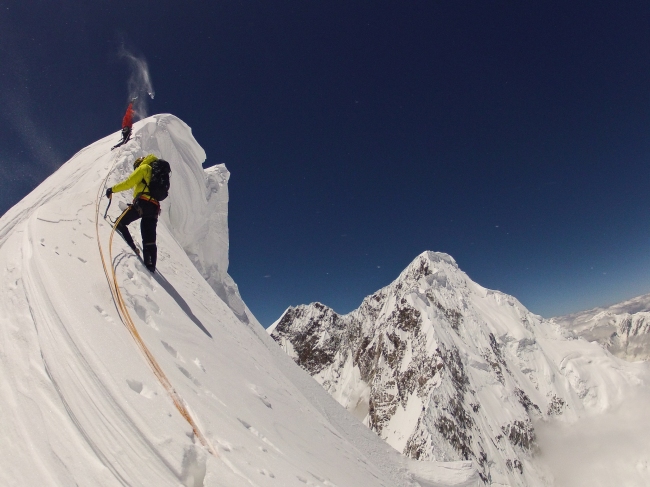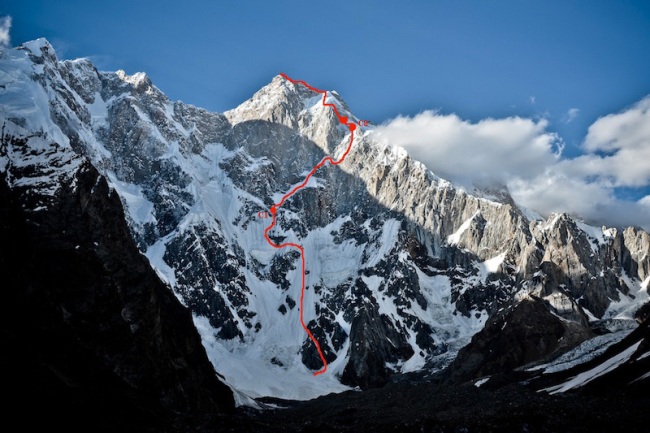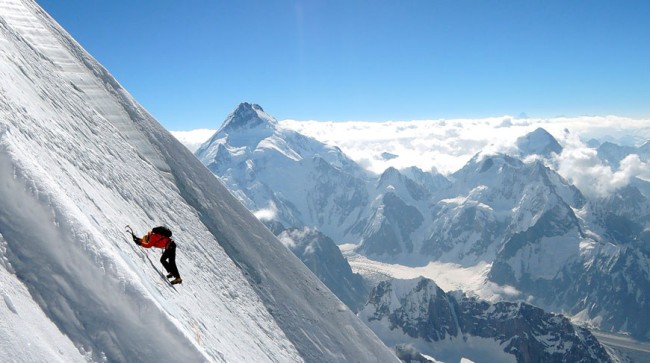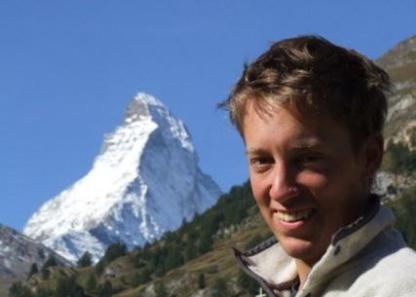Siblings are to be treasured. A silent bond which connects brothers and sisters, where words are not necessary and rules are understood. The Anthamattens are a talented family: Martin, Simon and Samuel have all achieved outstanding results in the mountaineering world, but do not boast about them.
I had already met Samuel for the Freeride World Tour in Courmayeur https://luciaprosino.wordpress.com/2014/01/20/being-bold-samuel-anthamatten/ and, in Chamonix for the Piolets D’Or , it was Simon’s turn. Together with Austrian Hansjorg and Matthias Auer, they opened a new line on the south-west face of Kunyang Chhish East (7400 mt), Karakorum, Pakistan, carried out in July 2013.
Soft-spoken and extremely determined, Simon has a clear-cut vision of mountaineering, and does not let awards or prizes get in the way of his adventures. He won a Piolet d’Or in 2009, in fact, for his ascent of north face of Teng Kang Poche – 6847 m, Khumbu Valley, Nepal – together with Ueli Steck. I was eager to find out his views on this much coveted award and how he sees the world of alpinism evolving.
How does it feel to be back at the Piolets d’Or? You are known for aiming at remote, wild places, aesthetic lines, something quite apart from what the majority usually does.
Well, that is not out of the ordinary at all! That is what everybody should be doing. First of all I set my eyes on a mountain, then I ask myself if it’s reachable or doable, then I consider my skills. I think there are still things which are too complex for our generation. In the end, however, I make choices according to what I’d like to climb, and not because I have a certain medal or recognition in mind. You are confronted with extremely hard situations: your motivation needs to be high to carry on, and cannot simply see you fighting for an award. All the people who have been nominated this year feel strongly about this. Our decisions are all about climbing, not the money we may obtain from a certain sponsor, for instance. Jokingly, I often say that it may be worth if the Piolets were made out of real gold, but they aren’t!
You are a mountain guide and I guess you earn your living primarily that way.
Do you see these expeditions as a sort of privilege, the chance to go and explore the places you choose? Even if they can be taxing at times? (This last Pakistan expedition lasted 55 days in total, of which 40 on the mountains.)
Well, that’s why it’s so important for you to choose the things you like. If I think about my older brother Martin and ski mountaineering, his goal is to be as fast as possible in order to win a race. In my case, I choose my own race. I may set myself to attain the hardest targets in the world, such as the west face of Makalu or the north face of Gasherbrum, which are still impossible at the moment, or else I could do something easier, maybe in the Alps. What is worth more? To try the hardest things or to opt for an easier target? The aim is to choose a challenge, one which you think you can obtain, but also one where the margin is not big, and that’s the creative side of alpinism. You choose your own way and it is sometimes hard for people to grasp this.
How did this Pakistan idea come about?
It was tried for the first time by a Polish team in 2003. Other people attempted, such as Steve House, and they could not reach the top. I was intrigued. Hansjorg, Matthias and myself decided to have a go. I’ve known them for quite some time and we make up a good team.
Would you say that this has been your hardest expedition so far?
Well, technically perhaps not, but mentally I’d say yes. I doubt it could have been any tougher from this point of view.
It must have been very committing. Will you tackle similar projects in the near future?
I have no projects at the moment. I’d rather do one expedition less, than too many. I always favour quality over quantity. I’ll be based around Zermatt for pretty much the rest of the year.
Can you tell me a few words about Jasemba (Simon opened a route on the south face, – 7350 m – in alpine style, together with his brother Samuel and Michael Lerjen, in 2009)?
That was an excellent adventure, together with two people I grew up with. We did not see anybody else other then our cook and porter for two months. We climbed what was, in my mind, the most logic line on the mountain, and it was tough, but good. I really enjoyed it because, once again, we did it for ourselves and did not have any recognition in mind.
The Anthamattens are a strong family of mountaineers. Do you often climb with your brothers?
No, not really. Samuel used to be my best climbing partner. He’s my brother and it’s easier when that’s the case. He’s always been more talented than me, although I feel I had the spleen to go through the end with things, but then he got into skiing and discovered that that is his main passion. He could combine his mountaineering background with skiing, which made him obtain outstanding results. He has focused on that and he has no space for anything else. Quite understandable, I’d say.
Simon is sponsored by Bayard Zermatt, Black Diamond, Mountain Hardwear, Scarpa and Julbo.

Hansjörg Auer, Simon Anthamatten and Matthias Auer on the summit of Kungyang Chhish East, Karakorum, Pakistan in July 2013 (Auer and Anthamatten Collection)

Hansjörg Auer, Simon Anthamatten, Matthias Aue, Kungyang Chhish East, Karakorum, Pakistan (Auer and Anthamatten Collection)

The line of the first ascent of Kungyang Chhish East, Karakorum, Pakistan in July 2013 (Auer and Anthamatten Collection)


